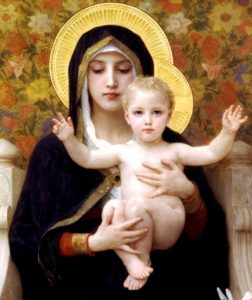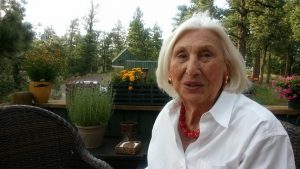
Suzanne Elizabeth Anderson
While I was enjoying my beach holiday, I received a call from a feature writer of our parish’s monthly bulletin. She wanted to interview me for an article about the “Living Rosary” group I’d started. It was nine a.m. in Florida, I was bleary-eyed as I hugged a cup of coffee and stared out at the ocean, and the interview began.
At the thirty-minute mark, I blurted out an answer so quickly and with such certainty that I knew it was not only an epiphany, but also that I wanted to share it with you.
I joined the Catholic church thirty years ago as an adult. Although I’ve often said that Mary brought me into the church, quite honestly, being raised Protestant, I often struggled with how I should relate to Mary. For years, I thought of her as distant, the image described in Revelations, a queenly figured wearing a crown surrounded by stars, standing on a globe with the ‘serpent’ crushed beneath her feet. “Hail, Holy Queen”.
There are saints in our church who say a complete rosary every day of the year. That’s five decades consisting of one Our Father prayer, ten Hail Mary’s, and Five Glory Be’s. That’s a lot of repetition.
To be honest, my mind often wandered as I tried to say an entire rosary. Which is why after reading an article about a Living Rosary, where a group of people commit to saying just one decade of a rosary per day, I was inspired to form a group within my church. My hope was that over the course of twenty weeks I would form the habit of saying the rosary each day and begin to understand what drew people to the rosary not out of obligation, but something they looked forward to.
I’m sorry to say that I failed to meet even this small daily goal more times than I succeeded, and I still didn’t understand the devotion felt by others.
So, I felt a like a fraud when the interviewer asked how the living rosary had changed my relationship with Mary. But that’s exactly the moment when God sent an epiphany that popped right out of my mouth before my skeptical brain had a chance to object. “Saying the rosary humanized Mary for me. It made me understand that she is a model of how we should live in relationship to God!”
Where did that come from? I’d never consciously had that thought before. Yet, once I said it out loud it made perfect sense. During the weeks of saying the rosary, I realized that each of the twenty ‘mysteries’ are Scripture-based events from the life of Jesus, from the visitation Mary first receives, to Jesus’ death and resurrection. The rosary points to the Bible, because it’s based on events from the Bible.
As I thought about this, I imagined one of the first scenes in which we encounter Mary, as portrayed in the First Joyful Mystery, when the Angel Gabriel appears and greets Mary saying, “Hail, full of grace, the Lord is with thee: blessed art thou among women.” Luke 1:28 Gabriel continues, saying, “Behold thou shalt conceive in thy womb, and shalt bring forth a son; and thou shalt call his name Jesus. He shall be great, and shall be called the Son of the most High; and the Lord God shall give unto him the throne of David his father; and he shall reign in the house of Jacob forever. And of his kingdom there shall be no end.” Luke 1:31-33
Mary’s first response is to question how this is possible. But then she states, “Behold the handmaid of the Lord; be it done to me according to thy word.” -Luke 1:38 And this is where I finally began to understand who Mary is and why I can see her as a model for my life and my relationship to God.
God has given Mary a unique purpose for her life. But first, Mary must agree by her own free will. She is being asked to step out into the unknown, to accept that God’s plan for her life is better than anything she could accomplish on her own. We are also asked by God to accept that he has a unique plan for our lives that first requires our trust.
After Jesus is born, we catch glimpses of Mary relating to Jesus as a mother relates to her child. I smile every time I think about Mary asking Jesus to turn the water into wine. This helped me to understand that God seeks an intimate, familial relationship with each of us. He wants us to come to him each day with our hopes, our grievances, our sorrow, and even our most ordinary requests.
Mary’s love for Jesus allows her to follow him all the way to the end, to stand at the foot of the cross as he is crucified. She demonstrates the trust to remain firm in our commitment to God even in our darkest hour, when all hope is lost. Mary’s loyalty is rewarded by Jesus’ consolation when he says to one of his disciples, “Behold, your mother,” and to Mary, “Behold, your son.” Just as Mary is never abandoned by Jesus, so we also will never be deserted in our desolation.
I now understand Mary as a godly woman I want to emulate. I want to surrender to God’s better plan for my life. I want to include God in every area of my life. I want to love God until the end of my life, when my heart is broken and when Jesus fills it with joy.
I look forward to saying the rosary with this new appreciation of Mary and her model of how we are called to a deeper relationship with God.

